Then a Treasure, Now Trouble…BIG Trouble…The Invasives
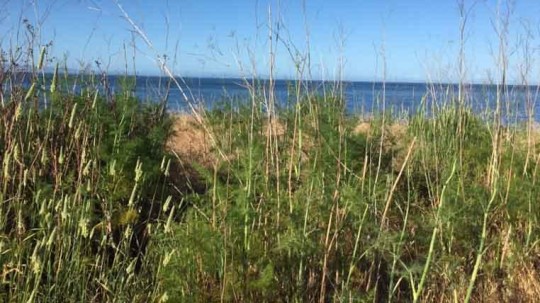 Some invasive plants move from their home territories via stealth. They hitchhike on boots, backpacks, clothing, packaging containers and ship bottoms. But, by in large, most were purposely transported from their homeland by humans who thought they were treasures that would be valuable in other, far-away places.
Some invasive plants move from their home territories via stealth. They hitchhike on boots, backpacks, clothing, packaging containers and ship bottoms. But, by in large, most were purposely transported from their homeland by humans who thought they were treasures that would be valuable in other, far-away places.
For this reason, our current Treasure Hunt looks at plants that seemed like something “heaven sent” at the time they were introduced, but today they are veritable nightmares. We will look at just a few of the current nightmares that plague our beautiful South Coast.
Rose Clover…Excellent, Cheap Fodder
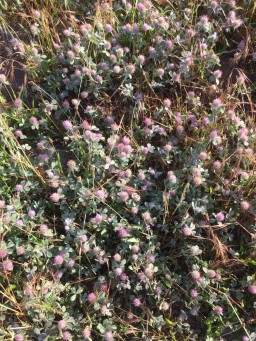
On a recent More Mesa walk, I became aware of lots and lots of pretty clover. This plant was low to the ground with thousands of pinkish colored flowers. It was everywhere, with huge patches beside the main trails. I had not remembered a lot of clover in the past, but this has been a strange year…on many fronts! So, I did some investigating. It appears that this is “Rose Clover” a native of Europe, Western Asia and North Africa and introduced to California, from Turkey, in 1944. I uncovered a pamphlet written by an agricultural branch of the University of California that was written in 1949. This document had nothing but kudos for a plant that could survive in the absolute worst of soils and was perfect for “Range Improvement”, that is, it is excellent fodder for cattle, sheep and deer. Today, Rose Clover, which is defined as “naturalized in the wild”, continues to be used extensively for these same purposes, as well as ground cover for vineyards. What does it do for More Mesa and other wild areas? It chokes out all the natives that were here for thousands of years.
Pampas Grass…Great “Cash Crop”
Originally from Argentina, Pampas Grass is an attractive ornamental grass that is popular in landscapes and extremely easy to grow. Pampas Grass was originally introduced to California by sailors of clipper ships during the gold rush. However, our very own Joseph Sexton (of the Sexton House on Hollister) created an entire, and extremely lucrative, industry in 1872, when he imported seeds of Pampas Grass from Argentina and raised several hundred plants. These first plumes were exported to Europe and became a huge fad…and a huge business for Sexton. For a complete, and wonderfully illustrated story of Pampas Grass in Goleta, visit Goleta History.
Not only was Pampas Grass very easy to grow but each individual plume produces up to 100,000 seeds…seeds that are widely dispersed by wind, and develop without fertilization! Moreover, California’s climate was a veritable heaven to the Pampas Grass plant. It spread quickly all over the state and became a rampant weed*. It took over, clogging waterways and wetlands and crowded out native plants and tree seedlings. It also crowded out the native plants that wild animals feed on. And to add to the fun…when dry, Pampas Grass becomes a fire hazard! In short, it created and still creates, nothing short of environmental chaos.

Although this plant is difficult to eradicate and has been described as a veritable scourge, it is still used extensively for landscaping gardens. Until about 10 years ago there were several large stands of Pampas Grass on More Mesa. We have not seen any recently, but they are still to be found in various spots around the Goleta Valley.
*This behavior does not occur in its native South American environments, where Pampas Grass grows on river plains where part of the year the crown is under water while the rest of the year the plant is stressed by drought.
Fennel…Good for What Ails You
Fennel history dates back to early Ancient Rome when the aromatic herb was used for a large number of medicinal and other purposes. The Greeks used it as a diet aid and the Romans, Chinese and Hindus used it as an antidote to various poisons. And, in medieval times, British Royalty used is as a condiment and appetite suppressant. Some folks during this period also believed that fennel could protect them from evil spirits…so they hung it over doorways. (Myself…I prefer mistletoe.) As for Fennel’s medicinal properties, Alphonse Karr, a writer of the late 1800s tried to put claims of fennel’s healing properties to rest with his announcement, “At the end of three or four hundred years, it began to be perceived that fennel had never cured anyone.” Having said this, I found pages and pages of sites touting Fennel’s medicinal benefits…especially for digestive issues.
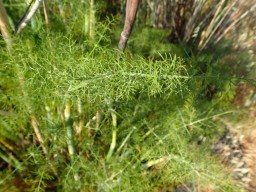
In general, Fennel has followed civilization, especially where Italians have colonized an area. It was originally introduced to North America by Spanish missionaries for cultivation in their medicinal gardens. However, after it escaped cultivation from the mission gardens, it may also have been aided and abetted by Italian immigrants who settled in the Goleta Valley. Among these newcomers was the family that ran the More Ranch Dairy and also began Jordanos. And speaking from personal experience, when I was a kid, my Italian family ate fennel root instead of celery…only we called it Finocchio…very tasty!
Fennel will reproduce from both root crown and seed. Seeds are dispersed by water and on vehicles and clothing. Birds and rodents eat the seeds and may disperse them as well. Fennel is all over the Goleta Valley and the coastal trail of More Mesa especially…outcompeting many natives…many of whom have disappeared. Fennel’s only “saving grace” is that it is a preferred food for Anise Swallowtails…as you may remember from our last Treasure Hunt. For more on Anise Swallowtails check out the butterfly section of our web site.
Tamarisk…Control Erosion
Since river running was a big part of my adult life, you are about to get another river camp story. We were again relaxing after an eventful day of Colorado River rapids in the deepest part of the Grand Canyon. I remarked that the trees we were sitting under were very pretty. The nearest river guide scowled and said they were Tamarisks. His face was not a happy face and the story that follows explains why.
What is Tamarisk?
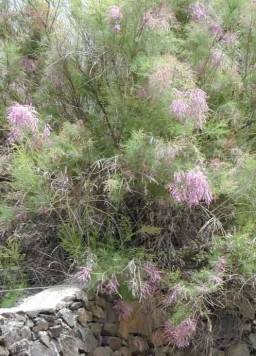 This treasure, also known as salt cedar, is a shrub or small tree originally from Eurasia and Africa. It took root, literally and figuratively, about 200 years ago…and did so with the blessing of the federal government. After importation, it was sometimes used as an ornamental or as a windbreak.
This treasure, also known as salt cedar, is a shrub or small tree originally from Eurasia and Africa. It took root, literally and figuratively, about 200 years ago…and did so with the blessing of the federal government. After importation, it was sometimes used as an ornamental or as a windbreak.
However, since Tamarisk loves water, its most important job was to prevent erosion. For this overriding consideration, it was subsequently planted along riverbanks across the United States, but mostly in the Southwest. It thrived and proliferated via seeds…with a single large tree producing 1,000,000 seeds per year.
It is interesting that the two previous plants and Tamarisk, all have feathery, fragile looking structures that totally belie their ability to “tough it out”, proliferate and totally eliminate natives; natives that probably have been here for thousands of years.
The Nightmare Begins
As it turned out, not only does Tamerisk have an insatiable thirst, but it has many qualities that are definitely not attractive! First, its tap root can reach down as much as 25 feet for water. Moreover, in the arid southwest most of water is very alkaline. So…the wily Tamarisk sucks up this alkaline water and then deposits the salt on its leaves…thereby increasing the salinity of surface soils when the leaves fall to the ground. Under these conditions, native trees like cottonwood and willows have no hope of survival. Tamarisk also burns hot in wildfires, complicating efforts of firefighters. And, to add insult to injury, after any burn, a reaction in the tree allows it to sprout back more vigorous than it was before the fire!
It Gets Worse
Erosion continued to be important but Tamarisk did not become a nightmare invasive until the beginning of the last century; a period when America began its love affair with dams. As a river runner, dams are not one of my favorite topics. However, as a scientist, objectivity must prevail.
Here’s how it works
With the construction of dams, rivers are no longer able to flush salt from ecosystems, and soils become even more alkaline. Since salt deters general plant growth, more salt makes matters worse for most plants. In addition, there are many more dry spells during which native plants die. But the Tamarisk is able to simply shut down and wait it out. This means that, in a Tamarisk laden, post-dam era, even greater amounts of salt will be brought up and deposited on their leaves and then onto the surface. Bottom Line:
Tamarisk plants, hoarding light, water and nutrients, have impacted natural systems and destroyed native wildlife habitat throughout the Southwest. Indeed, the Colorado River Corridor…where we were at the beginning of this story…is a national treasure, where Tamarisk has spread to such an extent that it has effectively wreaked havoc on all the natural functions and processes of the entire ecosystem.
Tamarisk now dominates riparian zones of arid climates over a million acres of the western United States. Indeed, it has the dubious distinction of being one of the top 100 invasives on the Global Invasive Species Database…which ranks all living material on the planet!
Can Anything Be Done?
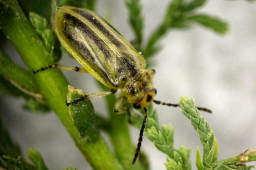
When Tamarisk was first recognized as a problem, there was talk of eradication. However, since the period of dam building, Tamarisk is so prevalent that it will never be completely eradicated…the best we can hope for is managing it. Since the late 1980s various methods to deal with Tamarisk have been tried…with little success. Millions of dollars have been spent by government and non-profit groups in attempts to remove, or even subdue, Tamarisk. You can’t burn it – it grows back. You can’t pull it out without great effort, and herbicides don’t necessarily work. However, over the last 20 years a successful biological pest control method is showing great promise. A leaf-eating beetle from the Tamarisk’s native range has been introduced into areas infested with the plant. Results have shown that if the beetles feed on a given plant for 3-5 years, it eventually dies. Many success stories in various states show that the beetles seem to be doing their job, as well as spreading out to find new areas of Tamarisk to defoliate and eventually wipe out. Some states have backed away from the beetle solution because an endangered bird now nests in Tamerisk. It’s complicated.
You can find Tamarisk along creeks on the South Coast.
Remember: Six Feet Apart and Stay Safe
Valerie
